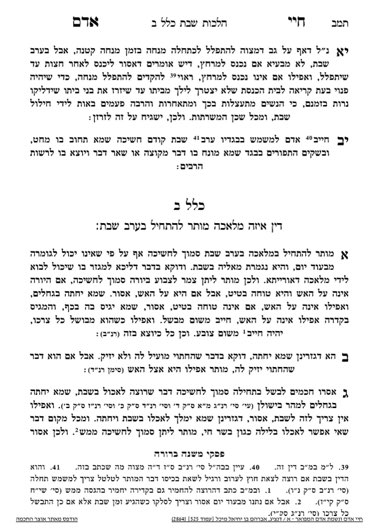We are beginning Klal 2, where the Chayei Adam will begin by discussing melachos performed on erev Shabbos which extend into Shabbos.
The issur from the Torah is performing melacha on Shabbos; melacha which takes place on Shabbos due to motions set in place before Shabbos is not assur from a Torah standpoint. Theoretically, this means that amira l’akum is muttar on a Torah level. This includes instructing a non-Jew on Shabbos itself, since the Jew is still refraining from melacha. Generally, the Torah instructs against melacha on Shabbos with the words lo saaseh, which implies active doing. There is one place where the Torah says lo yei’aseh, which implies that even melacha performed passively is assur. The Mechilta understands that this pasuk is a remez to the concept of amira l’akum; however, it is still only a din derabanan.
Chazal had a few concerns about a melacha set in motion before Shabbos to continue on Shabbos. They were concerned that a person may attempt to correct or enhance the melacha once Shabbos begins. For example, if one sets food on a fire, they may be tempted to adjust the coals. Another concern is maris ayin, that people who see the melacha taking place may assume the melacha was performed on Shabbos itself. A third concern is a melacha taking place which will be a zilzul of Shabbos, such as if it is loud or noisy in a way that detracts from the appropriate atmosphere of Shabbos.
The Chayei Adam begins by writing that, on a Torah level, a person can begin melacha on erev Shabbos, even right before Shabbos, and even if the melacha will continue into Shabbos itself. However, Chazal prohibited any melacha in which there may be a concern where one may get involved and actively perform melacha on Shabbos.
The Chayei Adam gives an example. Wool is dyed by mixing the dye with water, cooking the mixture, and then adding the wool and letting it cook slowly for a period of time. Putting the wool into the pot on Shabbos is the melacha of tzoveya, as they would dye the clothing of the cohanim and the curtains of the mishkan.
If one wishes to place the wool into the water before Shabbos, there are two concerns. One is that a person may stir, on Shabbos, the coals to add heat, and the other is the concern that one may stir the contents of the pot to help the wool better absorb the dye. Therefore, the Chayei Adam writes that if the pot is not on the fire, we avoid the first concern, and if the cover and pot are sealed with clay, we avoid the second concern. It is only in such conditions that it would be muttar to set up this wool and dye before Shabbos; otherwise, it is assur. We will discuss this concept further in the upcoming shiur, be’ezras Hashem.
Summary
Melacha set in motion to continue on Shabbos without any active participation of a Jew may still be assur miderabanan, out of concern that one will come to transgress Torah prohibitions in adjusting or enhancing the original melacha. Therefore, if the potential Torah prohibitions are obviated, the melacha will be muttar to set in motion before Shabbos.
Pesach 5783
Click here to watch Rabbi Reingold performing a Model Seder.



